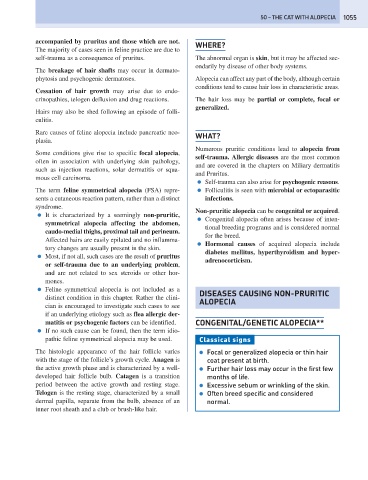Page 1063 - Problem-Based Feline Medicine
P. 1063
50 – THE CAT WITH ALOPECIA 1055
accompanied by pruritus and those which are not.
WHERE?
The majority of cases seen in feline practice are due to
self-trauma as a consequence of pruritus. The abnormal organ is skin, but it may be affected sec-
ondarily by disease of other body systems.
The breakage of hair shafts may occur in dermato-
phytosis and psychogenic dermatoses. Alopecia can affect any part of the body, although certain
conditions tend to cause hair loss in characteristic areas.
Cessation of hair growth may arise due to endo-
crinopathies, telogen defluxion and drug reactions. The hair loss may be partial or complete, focal or
generalized.
Hairs may also be shed following an episode of folli-
culitis.
Rare causes of feline alopecia include pancreatic neo-
WHAT?
plasia.
Numerous pruritic conditions lead to alopecia from
Some conditions give rise to specific focal alopecia,
self-trauma. Allergic diseases are the most common
often in association with underlying skin pathology,
and are covered in the chapters on Miliary dermatitis
such as injection reactions, solar dermatitis or squa-
and Pruritus.
mous cell carcinoma.
● Self-trauma can also arise for psychogenic reasons.
The term feline symmetrical alopecia (FSA) repre- ● Folliculitis is seen with microbial or ectoparasitic
sents a cutaneous reaction pattern, rather than a distinct infections.
syndrome.
Non-pruritic alopecia can be congenital or acquired.
● It is characterized by a seemingly non-pruritic,
● Congenital alopecia often arises because of inten-
symmetrical alopecia affecting the abdomen,
tional breeding programs and is considered normal
caudo-medial thighs, proximal tail and perineum.
for the breed.
Affected hairs are easily epilated and no inflamma-
● Hormonal causes of acquired alopecia include
tory changes are usually present in the skin.
diabetes mellitus, hyperthyroidism and hyper-
● Most, if not all, such cases are the result of pruritus
adrenocorticism.
or self-trauma due to an underlying problem,
and are not related to sex steroids or other hor-
mones.
● Feline symmetrical alopecia is not included as a
DISEASES CAUSING NON-PRURITIC
distinct condition in this chapter. Rather the clini-
ALOPECIA
cian is encouraged to investigate such cases to see
if an underlying etiology such as flea allergic der-
matitis or psychogenic factors can be identified. CONGENITAL/GENETIC ALOPECIA**
● If no such cause can be found, then the term idio-
pathic feline symmetrical alopecia may be used. Classical signs
The histologic appearance of the hair follicle varies ● Focal or generalized alopecia or thin hair
with the stage of the follicle’s growth cycle. Anagen is coat present at birth.
the active growth phase and is characterized by a well- ● Further hair loss may occur in the first few
developed hair follicle bulb. Catagen is a transition months of life.
period between the active growth and resting stage. ● Excessive sebum or wrinkling of the skin.
Telogen is the resting stage, characterized by a small ● Often breed specific and considered
dermal papilla, separate from the bulb, absence of an normal.
inner root sheath and a club or brush-like hair.

